Continuing from last time, Dentsu Inc. Youth Research Department researchers Minato and Nagi interviewed LoveGraph representatives Junpei Komashita and Atsumi Murata. Their insights revealed the complex romantic dynamics of young people navigating "popularity" and "appeal" within an information environment of constant connection.

(From left) Minato, Nagi, Komashita, Murata
Risk Hedging is Necessary to Avoid Being Seen as "Awkward"!?
Minato: By the way, Murata-san, you wrote about social bragging in your university thesis, right?
Murata: Yes, I listed the types of SNS used for social bragging and analyzed their characteristics and tendencies. For example, Instagram is a place for posting photos, so it's fundamentally a positive space where bragging comes easily. People don't really post negative photos, right?
Nagi: True...!
Murata: Facebook is real-name based, so it's harder to casually brag about your relationship. But since it's a place for status updates, posts like "I got married!"—which are part of relationship bragging—are easier to make. Twitter is a place where you can post pretty much anything, so the barrier to sharing relationship updates is low, but you're also more likely to get criticized, and so on.
Minato: I see. One reason Instagram is popular with young people lately might be that it's an environment where social bragging is easy.
Nagi: Why do you think young people do social bragging?
Murata: When today's 20-somethings were in elementary school, the internet was already fairly widespread. I'm 24, and around middle school, it was easy to make your own homepage. Services like "Mae-yaku Profile" and "Hompe" were popular, so I think this generation has no resistance to posting personal things online. Combined with that mindset, the spread of tools like smartphones and SNS that make posting easy might have increased the number of people who feel no resistance to social bragging.
Nagi: In our research on young people, we also consider their upbringing to be a key factor. How early they were exposed to SNS makes a big difference in their mental barriers.
But even within that, there's a balancing act—people watch each other and draw lines between what's "cool" and what's "embarrassing." Like, photos where your boyfriend isn't in the shot but you subtly hint you're with him are safe. But writing "Thanks for this gift. I'll treasure it" and tagging it with "#LOVE" is considered "awkward." Within this delicate balance, "Love Graph" at least provides an "excuse." Saying "I had this photo taken" when posting feels like a lower mental hurdle than saying "I went on a date with my boyfriend" (laughs).
Komashita: Even with couple photos, there's this vibe like "selfies are annoying," right? But photos taken by a photographer or pre-wedding shots are considered safe.
Minato: Coming-of-age ceremony photos are also relatively safe, right? In that sense, maybe what matters is how well you can make the day feel special.
Murata: "Love Graph" packages things a bit differently, including the couple's interview alongside the photos, making it a special experience. Creating that "excuse" is really important. Before, even if someone admired reader models and wanted photos taken, it was hard if they didn't get approached, right? With "Love Graph," you request it yourself, so you can say, "I went to get photos taken." You don't have to say, "I paid to get them taken."
Minato: It completely changes how it looks online. It hedges the risk of being seen as "embarrassing."
Murata: I think that's a really important difference for young people.
"Excuses" drive young people's romance!
Minato: When I interviewed college students before, they said events with overly romantic connotations like Valentine's Day or White Day don't really suit young people. Halloween and Christmas, on the other hand, have clear themes and seem like events everyone can enjoy together, even if they're not in a couple. Honestly, aren't Valentine's Day and White Day actually pretty slow for you?
Komashita: We don't get unusually high demand. Since Christmas is an event meant for couples to enjoy alone, few people ask us to take photos. If anything, summer and winter breaks tend to be busier.
Nagi: So it seems more people use the service during the everyday gaps between events, or to break out of a rut. By the way, there's a lot of data out there suggesting the number of couples is decreasing. Do you feel that?
Komashita: I can't say if they're decreasing, but there's definitely a tendency for people to want to say they're "uninterested in romance." Everyone's good at pretending to be "non-romantic," I guess. It's similar to the term "socially awkward" – by calling themselves "non-romantic" or "socially awkward," they're lowering their own expectations. It's not that romantic awareness has dropped; I think there's a sense that saying it's safer to be that way.
Nagi: Even though they say they're not interested, once they're in a relationship, they brag about it on social media, and at drinking parties, almost all the talk revolves around romance. There's no doubt today's youth are interested in romance and need it.
That said, if young people today are in an environment where they find it harder to pursue romance without an "excuse" or "reason" compared to the past, then media like "Love Graph" that provide that "excuse" are incredibly important for promoting young people's romantic lives. Romance also drives consumption, so it would be great if more services emerged to support young people's love lives.
Minato: There were also voices saying, "We want non-creepy encounters." Festivals aren't about meeting people either, but enjoying the music and meeting someone as a result is ideal.
Komashita: It's true, things like group dating events can be hard to join.
Nagi: Instead of calling it a mixer, they phrase it as "going out to eat with people you've never met before."
Minato: That's totally a mixer! (laughs) Why do you think that? Because information spreads instantly on social media?
Nagi: Also, I think there's this feeling that being overly aggressive about romance comes off as "awkward." A while back, it was considered good to just go for what you wanted with gusto. Of course, some young people today are still like that, but a new group has emerged that thinks, "Isn't that kind of awkward?"
When we analyzed young people's media communication at Wakamon before, we found even within the same youth group, they could be divided into 10 distinct clusters. For example, the "Self-Produced Character" and the "SNS Show-Off." The former actively posts photos with captions like "At Roppongi now" or "With famous so-and-so," and they don't really have that "awkward" sensibility. The latter type gathers obscure information online and shares it on SNS. They don't seem to be blatantly showing off, but they skillfully promote themselves. You can feel the "Look at me!" vibe (laughs).
Komashita: It's true, people do worry about how their posts will be perceived on social media.
Nagi: In that sense, the fact that the person being photographed can control whether or not to share the photos taken by "Love Graph" with just the right touch also matches young people's insights, right?
Komashita: When you think SNS could be seen by people worldwide, you have to be careful about every little thing you do. But I don't think it's true that young people aren't dating anymore. I just think it's become harder to be honest about it. They're playing the "non-real" card.
Murata: It's fashion non-real (fashion non-real refers to people who flaunt their lack of a fulfilling social life while actually having one).
Minato: Young people's desire to "fall in love!" never changes, no matter the era. Precisely because they're a generation deeply intertwined with SNS, it made me realize again how they maintain a subtle distance in how they approach and express romance.
Nagi: We want to keep researching so we can provide more people with natural, comfortable "excuses" like "Love Graph." Thank you for today.
<End>
【Wakamon Profile】
Dentsu Inc. Youth Research Department (nicknamed Wakamon) is a planning team that engages with the real lives and mindsets of young people, primarily high school and university students. We explore hints to brighten and invigorate the near future, starting from their "present." By anticipating the future through their insights, we realize new businesses that foster better relationships between young people and society. Currently, 19 project members are based across our Tokyo headquarters, Kansai branch, and Chubu branch. We also share updates on the Wakamon Facebook page.


















